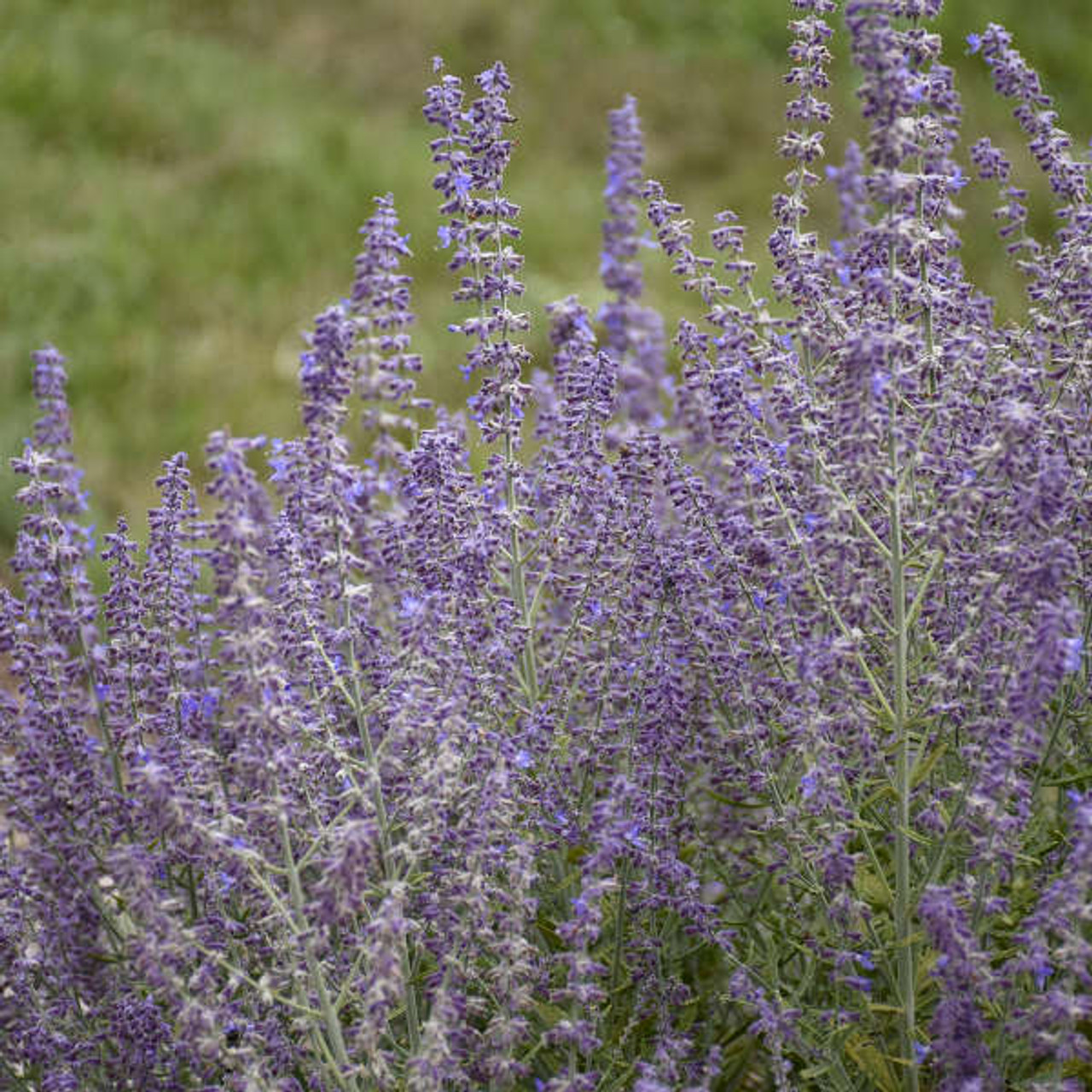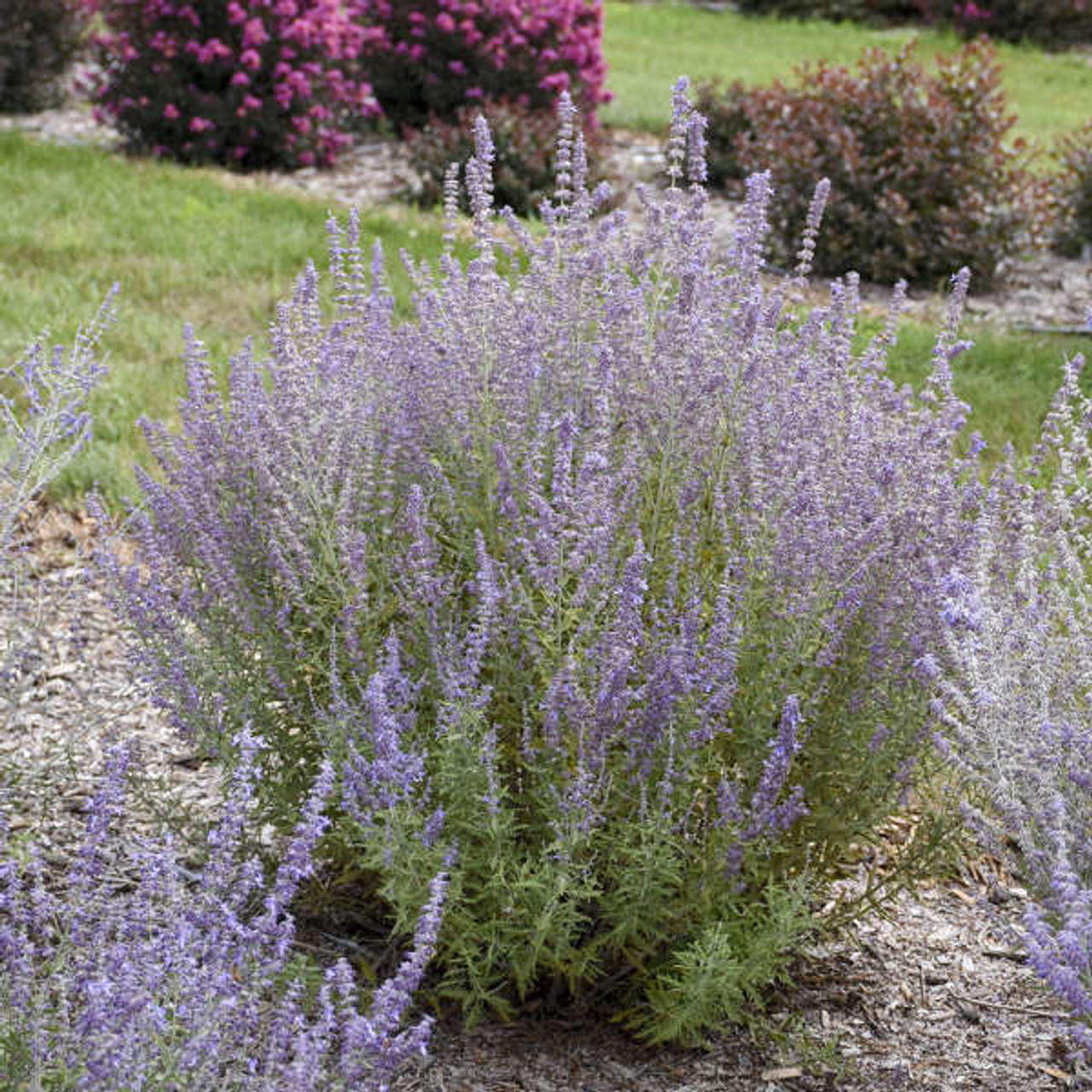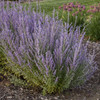Product Description
Perovskia atriplicifolia 'Sage Advice' PP33310 CPBRAF (25) Bare Root Plants
Common Name: Russian Sage
You would be wise to choose this Perovskia because it's the darkest purple shade to date. Rich lavender purple flowers are produced on strong, upright plants filled with oval-shaped, notched leaves. This is early to bloom just like its counterpart 'Denim 'n Lace', starting around late July in Michigan. Compared to 'Denim 'n Lace', this is a slightly taller variety with darker purple calyxes and broader leaves, compared to the dissected leaves of the former.
A perfect perennial for hot, dry climates and also exceptionally cold hardy. Perovskia can be used in a wide variety of environments with little attention through the season - a reason they have long been a staple of landscapers. Expect these plants to be a little later to emerge in spring, but also to offer color well into fall.
The ideal plant for hot, dry climates! Russian Sage is classified as a subshrub or woody perennial. It performs very well in full sun and any well-drained soil. Average to dry moisture levels are ideal, and few pests bother this plant. If pruning is necessary, do so in Spring when new growth appears. Prune back to just above the lowest bud.
Mississippi State University Ornamental Trial Top Performer -- 2021
Height: 32.0-36.0 Inches
Spread: 28.0-32.0 Inches
Hardiness Zones: 4,5,6,7,8,9
Flower Color: Purple shades
Foliage Color: Green shades, Silver/grey shades
Full Sun
Low to Average Water Needs
Poor to Fertile Soil Quality
Bloomtime: Midsummer to Early Fall
Attracts Hummingbirds
Deer Resistant
Seasonal Interest: Dried Seed Heads
Growth Rate: Medium
Border Plant, Cut Flower, Cut Foliage, Dried Flower, Drought Tolerant, Fragrant Flowers, Fragrant Foliage, Mass Planting, Salt Tolerant
Perovskia atriplicifolia 'Sage Advice' is a beautiful and reliable perennial, commonly known as Russian Sage, which adds a touch of silvery elegance and vibrant color to gardens. Here is a breakdown of its key features and growing requirements:
Key Features:
- Dark Purple Blooms: 'Sage Advice' boasts some of the darkest purple flowers among Russian Sage varieties, creating a striking contrast against its silvery foliage.
- Upright, Mounding Habit: It grows in a neat, upright, and mounding form, reaching about 32-36 inches tall and spreading 28-32 inches wide. This makes it suitable for various garden settings.
- Early Bloomer: It starts blooming in midsummer, earlier than some other Russian Sage varieties, and continues to produce flowers for weeks.
- Extended Color: Even after the flowers fade, the deep purple calyxes (the flower's protective covering) remain, providing extended color and interest.
- Fragrant Foliage: The silvery-green leaves are aromatic, releasing a pleasant sage-like scent when crushed.
- Drought and Deer Resistant: 'Sage Advice' is remarkably drought-tolerant once established and is also resistant to deer, making it a low-maintenance and worry-free choice.
- Attracts Pollinators: The flowers attract bees, butterflies, and hummingbirds, adding to the garden's ecological value.
Growing Conditions:
- Zones: 4-9 (It is hardy in a wide range of climates)
- Sun: Full sun is essential for best growth and abundant flowering.
- Soil: Prefers well-drained soil, but can tolerate a variety of soil types, including poor or sandy soils.
- Water: Once established, it is highly drought-tolerant, but it benefits from occasional watering during prolonged dry spells, especially in the first year.
Care Tips:
- Pruning: Prune in early spring before new growth begins. You can cut it back to a few inches above the ground to encourage a bushy habit.
- Deadheading: Deadheading (removing spent flowers) is not necessary, as the calyxes provide continued color.
- Fertilizing: Generally, it does not require fertilization, and too much fertilizer can lead to leggy growth.
Uses in the Landscape:
- Borders: Its upright and mounding habit makes it perfect for adding structure and color to borders.
- Mass Plantings: Planted in groups, it creates a stunning display of silvery foliage and purple blooms.
- Containers: It thrives in containers, adding vertical interest to patios and decks.
- Dry Gardens: Its drought tolerance makes it ideal for dry gardens or xeriscapes.
- Cut Flowers: The long-lasting flowers are excellent for cutting and arranging.
If you are looking for a beautiful, low-maintenance, and pollinator-friendly perennial, Perovskia atriplicifolia 'Sage Advice' is an excellent choice. Its unique combination of silvery foliage and dark purple flowers will add a touch of elegance and vibrancy to your garden.
Other Details
The most important part of the plant is its root system. Healthy roots are the foundation of a healthy, vibrant plant. The type of plug container used is based on the specific needs of the plants. Perennials offered as bare root traditionally perform better when planted as bare root.Planted in a specialized mix, potted plants have well established root systems. Top growth stage will vary depending on the current life cycle and time of year when shipped. In Winter and early Spring dormant plants may be shipped. Dormant plants may be planted right away, even before the last frost date.
Most bare root varieties are field grown for at least one season, though Hemerocallis and Hosta are grown for two seasons. The bulk of the soil is removed during the harvesting process and the tops of most varieties are trimmed back to the crown. They are graded, packed in shredded aspen or sphagnum moss and stored in freezers until ready to be shipped.
See our Container Sizes and Bare Root Perennials pages for more information.
Plant information and care is provided in the Overview section, Plant Genus Page and general information is provided in the Planting Care & Guides. Additional questions can be asked on each Plant page.
Plant Spacing: Using the maximum mature spread or width of a plant to guide spacing, ensures space to grow to full size. To fill an area sooner, plant them closer together. Just remember, future thinning or transplanting may be needed.
Water: Keep a close eye on newly planted perennials, especially throughout the first growing year. Most early plant loss is due to too much or too little water!








